Acute Effect of Central Administration of Urotensin II on Baroreflex and Blood Pressure in Conscious Normotensive Rabbits
- PMID: 28280470
- PMCID: PMC5322237
- DOI: 10.3389/fphys.2017.00110
Acute Effect of Central Administration of Urotensin II on Baroreflex and Blood Pressure in Conscious Normotensive Rabbits
Abstract
In the present study, we examined the effects of central administration of Urotensin II on blood pressure, heart rate, and baroreceptor heart rate reflexes in conscious normotensive rabbits. Preliminary operations were undertaken to implant a balloon cuff on the inferior vena cava for baroreflex assessments and to implant cannula into the lateral and fourth ventricle. After 2 weeks of recovery cumulative dose response curves to Urotensin II (10, 100 ng, 1, 10, and 100 μg) given into the ventricles, or Ringer's solution as a vehicle were performed on separate days. Injections were given each hour and baroreflex assessments were made 30 min after each administration. Analysis of the dose response curves to Urotensin II compared to vehicle administered into the lateral or fourth ventricle, indicated little change to blood pressure or heart rate. Analysis of the time course to the highest dose over a 30 min period revealed a small (-5 mmHg) depressor response maximal at 10 min when injected into the fourth ventricle but no effect when injected into the lateral ventricle. Baroreflex assessments made at each dose showed that there was no change in baroreflex sensitivity but that an increase in the upper plateau was observed when Urotensin was injected into the lateral ventricle and a tendency for a reduced lower heart rate plateau was observed after fourth ventricle administration. Clonidine administration in the fourth ventricle decreased blood pressure and heart rate, thus confirming catheter patency. In conclusion, our findings suggest that Urotensin II in the forebrain and brainstem may play a role in modulating cardiac sympathetic and vagal baroreflexes but only during large acute changes in blood pressure.
Keywords: Urotensin II (SD1293); baroreflex; blood pressure; central effect; conscious rabbit.
Figures
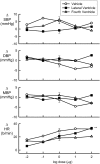
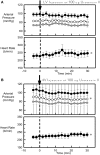
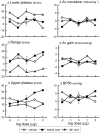
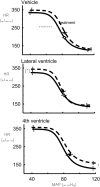
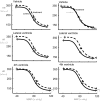

Similar articles
-
Comparison of the baroreceptor-heart rate reflex effects of moxonidine, rilmenidine and clonidine in conscious rabbits.J Auton Nerv Syst. 1998 Oct 15;72(2-3):195-204. doi: 10.1016/s0165-1838(98)00105-2. J Auton Nerv Syst. 1998. PMID: 9851569
-
Involvement of imidazoline receptors in the baroreflex effects of rilmenidine in conscious rabbits.J Hypertens. 2001 Sep;19(9):1615-24. doi: 10.1097/00004872-200109000-00014. J Hypertens. 2001. PMID: 11564982
-
Role of AT1 receptors in the central control of sympathetic vasomotor function.Clin Exp Pharmacol Physiol Suppl. 1996;3:S93-8. Clin Exp Pharmacol Physiol Suppl. 1996. PMID: 8993846
-
Baroreflexes and cardiovascular regulation in hypertension.J Cardiovasc Pharmacol. 1995;26 Suppl 2:S7-16. J Cardiovasc Pharmacol. 1995. PMID: 8642810 Review.
-
Role of AT1 receptors in the central control of sympathetic vasomotor function.Clin Exp Pharmacol Physiol. 1996 Sep;23 Suppl 3:S93-8. doi: 10.1111/j.1440-1681.1996.tb02820.x. Clin Exp Pharmacol Physiol. 1996. PMID: 21143280 Review.
References
-
- Australian Code of Practice for the Care and Use of Animals for Scientific Purposes 7th Edition (2004). Canberra, ACT: Australian Government Publishing Service.
LinkOut - more resources
Full Text Sources
Other Literature Sources

